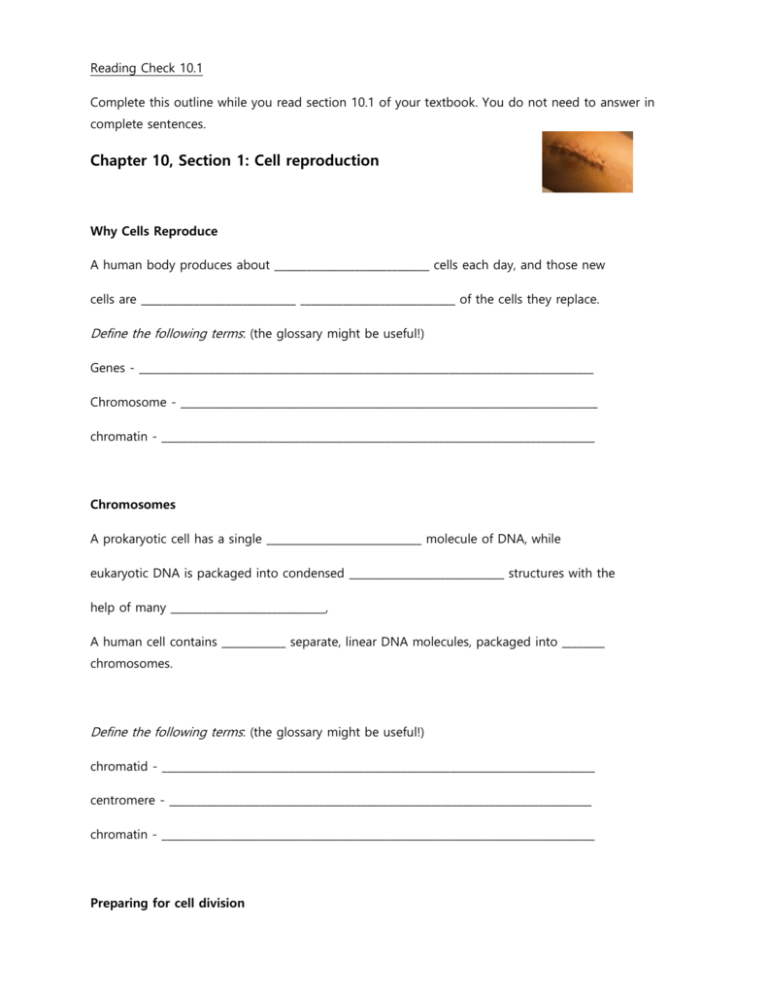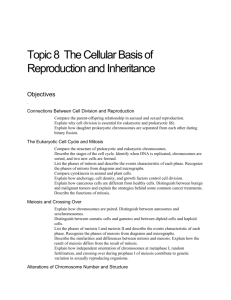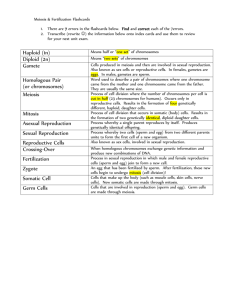reading check ch10
advertisement

Reading Check 10.1 Complete this outline while you read section 10.1 of your textbook. You do not need to answer in complete sentences. Chapter 10, Section 1: Cell reproduction Why Cells Reproduce A human body produces about _____________________________ cells each day, and those new cells are _____________________________ _____________________________ of the cells they replace. Define the following terms: (the glossary might be useful!) Genes - _____________________________________________________________________________________ Chromosome - ______________________________________________________________________________ chromatin - _________________________________________________________________________________ Chromosomes A prokaryotic cell has a single _____________________________ molecule of DNA, while eukaryotic DNA is packaged into condensed _____________________________ structures with the help of many _____________________________, A human cell contains ____________ separate, linear DNA molecules, packaged into ________ chromosomes. Define the following terms: (the glossary might be useful!) chromatid - _________________________________________________________________________________ centromere - _______________________________________________________________________________ chromatin - _________________________________________________________________________________ Preparing for cell division All new cells require ____________, so before a cell divides, a new copy is made for each daughter cell. When a ________________________ cell divides, its circular DNA molecule is copied before the parent cell’s cytoplasm is split into two. Reproduction in _______________________ cells is more complex because these cell types have many _______________________, and their DNA is protected within the _______________________. Reading Check 10.2 Complete this outline while you read section 10.2 of your textbook. You do not need to answer in complete sentences. Chapter 10, Section 2: Mitosis Eukaryotic cell cycle The cell cycle is a repeating sequence of cellular ____________________ and ____________________ during a cell’s life. The first three phases of the cell cycle, G1, S and G2 are known as _______________________. Briefly describe what happens during each phase of the cell cycle. Interphase ______________________________________________________________________________ G1 ______________________________________________________________________________ S ______________________________________________________________________________ G2 ______________________________________________________________________________ Mitosis ______________________________________________________________________________ Cytokinesis ______________________________________________________________________________ Stages of mitosis Briefly describe what happens during each phase of mitosis. Prophase ______________________________________________________________________________ Metaphase ______________________________________________________________________________ Anaphase ______________________________________________________________________________ Telophase ______________________________________________________________________________ Cytokinesis The end result of mitosis and cytokinesis are two genetically ____________________ cells. In cells that lack cell walls, the cytoplasm in the cell is pinched in half by a belt of ____________________ threads. In cells with rigid cell walls, ____________________ holding the material for the new cell wall line up across the middle of the cell and fuse to form the large, membrane-bound cell wall called the cell ____________________. Reading Check 11.1 Complete this outline while you read section 11.1 of your textbook. You do not need to answer in complete sentences. Chapter 11, Section 1: Reproduction __________________ is the process of producing offspring. Asexual reproduction An individual formed by asexual reproduction is genetically __________________ to it parent. Prokaryotes reproduce asexually using __________________ __________________. Some multicellular eukaryotes can go through __________________, during which the body breaks into several pieces, and the fragments regrow into complete adults. Some animals can go through __________________, when new individuals split off from existing ones. The females of some species can undergo _________________________, in which a female makes an egg that grows into an adult without ever being fertilized by a male. Sexual reproduction True or false: Not many eukaryotic organisms reproduce sexually. ________ In sexual reproduction, ________ parents give genetic material (DNA) to produce offspring that are genetically __________________ from their parents. Each parent contributes one reproductive cell, called a __________________, and those two cells fuse in a process called __________________. The resulting cell is called a __________________. Cells that are specialized for reproduction are called __________________ cells. Only these types of cells can produce gametes. Other body cells are called __________________ cells, and these do not participate in sexual reproduction. Asexual reproduction is the most __________________ method of reproduction, because it allows organisms to produce many offspring quickly and without using energy to make __________________ or find a __________________; however, the genetic material in these organisms varies very little, so they might be at a disadvantage in a changing __________________. Sexual reproduction produces genetically __________________ individuals, and those diverse individuals are more likely to have some members that will survive and major environmental __________________. In humans, each cell has two copies of _____ chromosomes, for a total of _____. __________________ chromosomes are similar in size, shape, and gene type, but they are not identical because they are inherited from different parents. __________________ are chromosomes that do not determine the sex of an individual. (You have 22 pairs of them! Sex chromosomes have genes that determine the sex of an individual. Human males have one _____ chromosome and one _____ chromosome. Human females have two _____ chromosomes. Reading Check 11.2 Complete this outline while you read section 11.2 of your textbook. You do not need to answer in complete sentences. Chapter 11, Section 2: Meiosis Meiosis is a form of cell division that produces daughter cells with __________________ the number of chromosomes that are in the parent cell. Stages of meiosis In meiosis, a __________________ cell goes through _____ divisions to form ______ haploid cells. In meiosis I, _____________________ _____________________ are separated. In meiosis II, _____________________ chromatids are separated. During prophase I, sister chromatids exchange DNA in a process called _____________________. In anaphase I, the _____________________ _____________________ separate. Meiosis II begins with _____ new cells, which were formed at the end of telophase I. In _____________________ II, the chromatids move to opposite poles of the cell. The result of meiosis is _____ haploid cells. Comparing mitosis and meiosis Mitosis makes new cells that are used during _____________________, _____________________, _____________________ and _____________________ reproduction. Meiosis makes cells that enable an organism to reproduce _____________________, and it happens only in _____________________ structures. Mitosis produces _____ genetically _____________________ _____________________ cells. Meiosis produces _____ genetically _____________________ _____________________ cells. The main difference between meiosis and mitosis is that in meiosis, _____________________ information is rearranged. This leads to genetic _____________________ in offspring. Genetic variation The three key contributions to genetic variation are _____________________, _____________________ _____________________, and _____________________ _____________________. _____________________ occurs during prophase I, which homologous chromosomes (one from each parent) exchange DNA. _____________________ _____________________ is the random distribution of homologous chromosomes during meiosis. _____________________ _____________________ refers to the random joining of two gametes.









